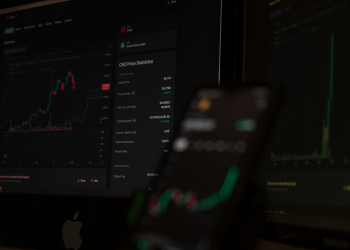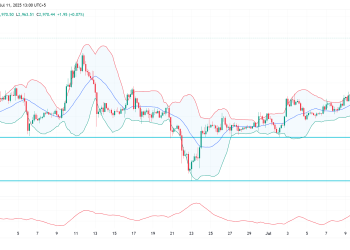The Dow Jones Industrial Average has experienced a 1% uptick in the first two trading days of this week after three straight weeks of declines. Additionally, data from the US Producer Price Index show stronger inflation than was predicted. Although a humanitarian crisis in Gaza is anticipated as a result of the Israel-Hamas conflict, it is interesting that gasoline prices have surprisingly continued to fall. Furthermore, the longer-dated portion of the yield curve shows a decline in Treasury yields. This Friday will mark the start of earnings season and the release of JPMorgan’s Q3 earnings, a Dow component.
The Dow Jones Industrial Average (DJIA) appears to be having a positive reversal on the daily chart because this week’s gains come after last week’s consolidation. After three weeks of fall, the index has recovered in each of the last three trading sessions, returning 0.87%, 0.59%, and 0.40%, respectively.
Initial worries that the Israel-Hamas war would cause a sell-off in the equity market over the weekend proved unfounded; instead, US stocks have surprisingly gained. Oil prices have reversed their sharp rise after Saudi Arabia made statements meant to ease regional concerns. In fact, on Wednesday, the price of West Texas Intermediate (WTI) futures fell under $85 a barrel.
The Israel-Palestine conflict has an odd side effect in that it has caused a surge in safe-haven investments into US Treasury securities. Due to its inverse relationship and the recent boom in bond purchases, yields have decreased as bond prices have increased. Given that recent drops in the Dow Jones and other stock indexes were a result of rising Treasury rates, the decrease in yields is currently boosting demand for equities.
Additionally, US Federal Reserve officials have recently played down the necessity of further rate increases for the year. The idea that Treasury yields have already risen to a level that is sufficient is being supported by these statements.
The release of the Producer Price Index (PPI), which as of Wednesday revealed greater core inflation levels than what analysts had anticipated, may serve as a potential counterbalance to the bullish outlook for stocks. To find out if this trend affects the larger consumer class, traders may wait for Thursday’s Consumer Price Index (CPI).
Finally, as the start of the earnings season is this Friday, the performance of the Dow Jones Industrial Average depends on JPMorgan’s (JPM) impending third-quarter earnings release.
Dow Jones Update: The Effect of Treasury Yields on the Stock Market
Both the 10-year and 30-year US Treasury yields have significantly decreased by 2% in the premarket on Wednesday, while the yields on the 3-month and 6-month Treasury notes have slightly increased. Following recent steps towards a more balanced curve, this trend is further flattening the yield curve.
The 30-year Treasury recently experienced its first 5% yield since 2007 in September. However, the 30-year yield has decreased to 1.71% as of Wednesday.
On Tuesday, Mary Daly, president of the San Francisco Fed Bank, suggested that the recent rise in Treasury yields would be seen as a substitute for higher interest rates, which might result in less spending and investment. This posture suggests that the central bank is less obligated to hike rates further, which is positive for the Dow Jones.
Lorie Logan, the president of the Dallas Federal Reserve Bank, said this week that if long-term Treasury yields stay high, additional interest rate increases may not be required to fight inflation. The vice chairman of the Federal Reserve, Philip Jefferson, also issued a warning on the need for care when tightening monetary policy.
Formerly in favour of further rate hikes, Atlanta Federal Reserve Bank President Raphael Bostic said on Tuesday that the current monetary policy is now appropriately restrained and that inflation will return to 2% without sparking a recession.
Data from the CME FedWatch Tool shows that traders believe there is an 84% chance that the Fed will keep interest rates constant in November and a 71% chance that it will do so in December. This is excellent news for those who predict that rate reductions will boost stock prices significantly the next year as a result of improved profits and valuations. By the middle of 2024, Stephen Parker of JPMorgan already expects fresh highs in the equity market.
Traders are still concerned about inflation. The most recent monthly Producer Price Index for September was released by the US Bureau of Labour Statistics just before the market opened on Wednesday. This exceeded economists’ projections of 0.2% monthly growth and 2.3% annual growth, revealing a worrisome trend in core inflation with a 0.3% month-over-month increase and a 2.7% annualised rise.
This worrying information would encourage some market participants to forecast a possible rise in inflation, which might push the US central bank to think about hiking interest rates, which could bring on another drop in the stock market.
Investors will now focus on the CPI data released on Thursday to determine whether the higher inflation shown in the Core PPI also affects the larger consumer market. According to market expectations, the annual growth rate of core CPI will drop from 4.3% in August to 4.1% in September, while the monthly core CPI for September is predicted to increase by 0.3%, matching August’s results.
This October, JPMorgan begins the earnings season. Before the market starts, the well-known Dow member, along with Wells Fargo and Citigroup, will release their Q3 results. All Wall Street analysts now expect higher earnings for JPMorgan in the third quarter. The anticipated top and bottom lines are expected to increase by more than 20% from the prior year, with the consensus currently at $3.87 per share in earnings (EPS) on $39.3 billion in revenue. The anticipation surrounding these large banks has grown, especially after Pepsico (PEP) surprised analysts by reporting strong profits earlier this week, defying predictions that the maker of snacks and beverages may be negatively affected by new weight-loss medications.
With a market value of more than $420 billion, JPMorgan is one of the biggest businesses on the US stock market and has the power to dramatically impact a larger market upswing that benefits the Dow Jones, as it did during the Q2 earnings release. Given its extensive presence in the banking industry, JPMorgan is frequently used as a gauge for the whole earnings season.
Walgreens Boots Alliance (WBA), a failing Dow company, is scheduled to release its third-quarter results on Thursday. The chain of stores and pharmacies is anticipated to generate adjusted earnings of $0.69 per share and $34.8 billion in revenue. This earnings call is particularly intriguing because Tim Wentworth, a former Cigna executive, was just named as Walgreens’ new CEO.
















